Rome tour guide John Fort finds some favourite places in the city to wander in peace and tranquillity
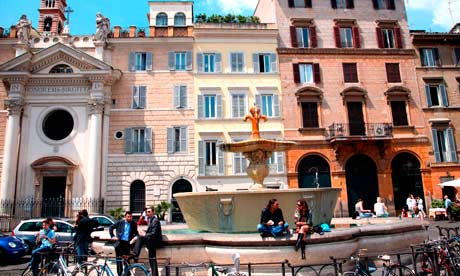
Piazza Farnese
Dominated by that magificent monument to papal hubris, the 16th-century Palazzo Farnese (pictured above), now the French embassy, and the twin fountains created out of enormous Roman granite bathtubs, the largest in existence, the Piazza Farnese is one of the finest outdoor drawing rooms of the city. To enjoy the square, either sit on the stone benches which run along the façade of the palace, or take a cup of coffee in the Caffè Farnese at the corner with Via dei Baullari. You could also settle down for a good meal at the restaurant in the corner, Ar Galletto, an old-fashioned trattoria serving classic Roman dishes (closed on Sundays).
• Piazza Farnese
• Piazza Farnese
Villa Torlonia
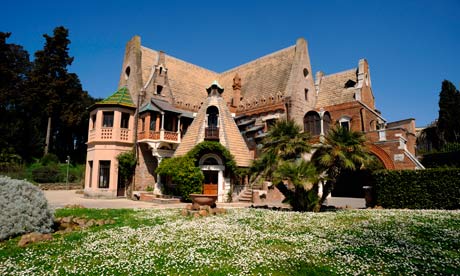
The park of the Villa Torlonia is set round a somewhat self-important mansion dating from the first decades of the 19th century and built for the immensely wealthy banking family, the Torlonias. It became Mussolini's residence from 1925. The main house is decorated pompously, but the bedroom used by Mussolini contains some of his handsome art deco furniture. The park contains many fine trees and handsome stands of huge bamboos, and sprinkled throughout it are assorted buildings in various states of repair, such as a theatre, a small museum of Roman statuary, and the enchanting House of the Owls (Casa delle Civette), art nouveau in style, with a roof in multicolured tiles, blues, red, turquoise, and housing some beautiful Roman stained-glass works.
• Via Nomentana 70, museivillatorlonia.it. Park open every day from dawn to dusk, main house and Casa delle Civette from 9am-7pm. Entrance to the park is free, combined entrance to the villa and the Casa delle Civette €10, free for EU citizens under-18s or over-65s
• Via Nomentana 70, museivillatorlonia.it. Park open every day from dawn to dusk, main house and Casa delle Civette from 9am-7pm. Entrance to the park is free, combined entrance to the villa and the Casa delle Civette €10, free for EU citizens under-18s or over-65s
Santa Costanza
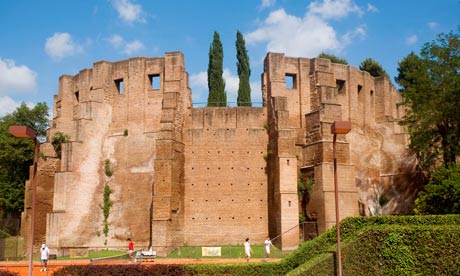
This enchanting circular chapel dates to the middle of the 4th century AD and is the earliest church in the city surviving more or less in its original form, with exquisite mosaics covering much of the ceiling. Constantia (Costanza) was the daughter of the emperor Constantine and built this as her mausoleum. It is part of a religious complex containing another ancient church (S Agnese, early 7th century and also with beautiful mosaics) and catacombs. As you enter through the gate on the Via Nomentana and wander around the courtyards, ramps and gardens, there is a feeling of going back 1,600 years, leaving behind sounds of traffic and the dreary suburban surroundings. Santa Costanza and the Villa Torlonia are about 600 metres apart and can easily be combined.
• Via Nomentana 349. Open Mon 9am-noon, Tue-Sat 9am-noon and 4pm-6pm, Sun 4pm-6pm. Free
• Via Nomentana 349. Open Mon 9am-noon, Tue-Sat 9am-noon and 4pm-6pm, Sun 4pm-6pm. Free
Villa Borghese
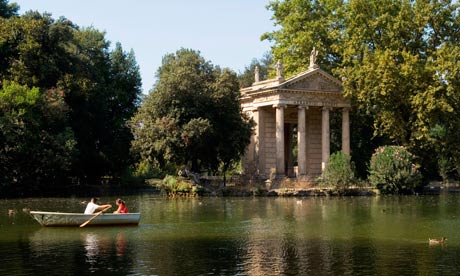
The enormous Borghese park contains the Borghese Gallery, but also many other delightful buildings and follies, an artificial lake with a temple, an aviary, an orangery and much more in a carefully landscaped setting created in the English style for the Borghese family by the Scottish artist Jacob More in the 1770s. There are various entrances, but the main one is from just outside the Piazza del Popolo, from the Pincio gardens along from the Spanish Steps and from the top of the Via Veneto. This is much the largest area of green anywhere near the centre of the city, and provided you do not object to dogs being walked, it is a delight to lie on the grass under the towering umbrella pines or stroll right the way across towards the Etruscan Museum, the Gallery of Modern Art or the zoo.
• Via Veneto. Open every day from dawn to dusk. Free
• Via Veneto. Open every day from dawn to dusk. Free
Cloister of Sant'Andrea delle Fratte
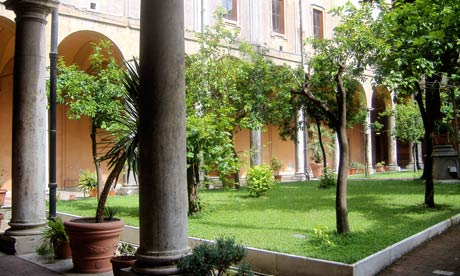
Photograph: Juliana Brint on Flickr/All rights reserved
A miraculously quiet spot, considering you are within a few hundred yards of the Trevi fountain on one side and Spanish Steps on the other. It is best to enter from the Via della Mercede, have a look at Bernini's magnificent statues of angels to your left, and then slip through the doors on the far side into the peaceful, slightly decrepit cloisters. A fountain thickly covered in fern and moss drips quietly at the centre, lemons and cypresses scent the air. There is nowhere to sit, but this is where to come if you wish to regain your calm after a hectic morning of shopping or of battling round the big tourist draws of the area.
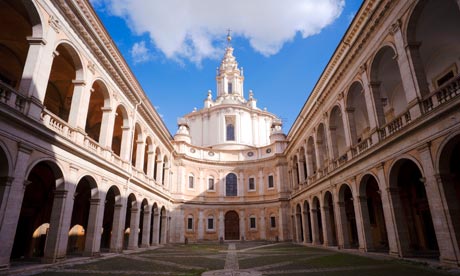
Enter this glorious courtyard, lined on three sides with a sober, handsome double portico, either through the main entrance at Corso Rinascimento 40, or if you have been visiting the Pantheon, from Via del Teatro Valle VI/VII. This was once the university of Rome (hence Sapienza – wisdom), and dates mostly from the second half of the 16th century, except for the great, white church of Sant'Ivo at the end, one of Borromini's most sublime creations, with the extraordinary spiral creation that soars above it. Annoyingly, the only way to see the equally original interior of the church is when it opens for mass on Sundays 10am-noon. There may well be a group of keen young students of architecture sketching away in a corner, but they will not disturb the mixture of amazement and tranquillity engendered by this building.
• Corso Rinascimento 40 or Via del Teatro Valle VI/VII. Open 7.30am-8pm. Free
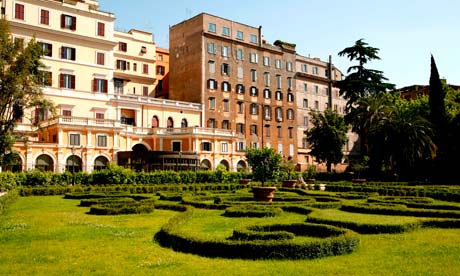
The Palazzo Barberini is one of the grandest of papal palaces, now looking even more magnificent after years of restoration. It houses the main state collection of paintings up to 1700 (including Holbein's portrait of Henry VIII and many other treasures), but unexpectedly the visitor, without buying a ticket, can wander all round the grounds of the palace. Enter through the very grand gates, have a quick glance at the glorious elliptical spiral staircase (Borromini) to be found through the doors on the right side, and then pass under the building, up a long ramp, to the terraces and gardens behind, where you can wander in peace and tranquillity and often in solitude. On the way out also look at the square staircase (Bernini) through the doors on the other side of the building.
• Access to the Palazzo Barberini, Via delle Quattro Fontane 13, +39 06 32810, galleriaborghese.it/barberini/en/einfo.htm, 8.30am-7.30pm. The building and gardens can be visited every day (no charge), but the gallery is closed on Mon. Entrance to the gallery €5. Free entrance to citizens of the EU who are under 18 or over 65
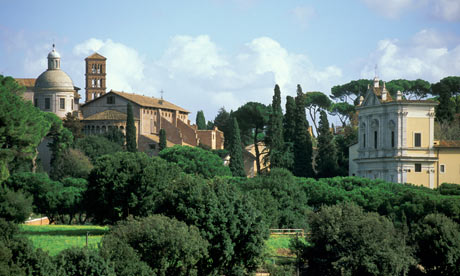
A miraculously quiet spot, considering you are within a few hundred yards of the Trevi fountain on one side and Spanish Steps on the other. It is best to enter from the Via della Mercede, have a look at Bernini's magnificent statues of angels to your left, and then slip through the doors on the far side into the peaceful, slightly decrepit cloisters. A fountain thickly covered in fern and moss drips quietly at the centre, lemons and cypresses scent the air. There is nowhere to sit, but this is where to come if you wish to regain your calm after a hectic morning of shopping or of battling round the big tourist draws of the area.
• Via della Mercede. The church is open 8am-12.30pm and 4pm-7pm, but the cloisters only in the morning. Entrance at Via S Andrea delle Fratte 1, or from the side on Via della Mercede. Free
Courtyard of Sant'Ivo alla Sapienza

Enter this glorious courtyard, lined on three sides with a sober, handsome double portico, either through the main entrance at Corso Rinascimento 40, or if you have been visiting the Pantheon, from Via del Teatro Valle VI/VII. This was once the university of Rome (hence Sapienza – wisdom), and dates mostly from the second half of the 16th century, except for the great, white church of Sant'Ivo at the end, one of Borromini's most sublime creations, with the extraordinary spiral creation that soars above it. Annoyingly, the only way to see the equally original interior of the church is when it opens for mass on Sundays 10am-noon. There may well be a group of keen young students of architecture sketching away in a corner, but they will not disturb the mixture of amazement and tranquillity engendered by this building.
• Corso Rinascimento 40 or Via del Teatro Valle VI/VII. Open 7.30am-8pm. Free
Gardens of Palazzo Barberini

The Palazzo Barberini is one of the grandest of papal palaces, now looking even more magnificent after years of restoration. It houses the main state collection of paintings up to 1700 (including Holbein's portrait of Henry VIII and many other treasures), but unexpectedly the visitor, without buying a ticket, can wander all round the grounds of the palace. Enter through the very grand gates, have a quick glance at the glorious elliptical spiral staircase (Borromini) to be found through the doors on the right side, and then pass under the building, up a long ramp, to the terraces and gardens behind, where you can wander in peace and tranquillity and often in solitude. On the way out also look at the square staircase (Bernini) through the doors on the other side of the building.
• Access to the Palazzo Barberini, Via delle Quattro Fontane 13, +39 06 32810, galleriaborghese.it/barberini/en/einfo.htm, 8.30am-7.30pm. The building and gardens can be visited every day (no charge), but the gallery is closed on Mon. Entrance to the gallery €5. Free entrance to citizens of the EU who are under 18 or over 65
Villa Celimontana and Parco del Celio on the Celio Hill

Photograph: Alamy
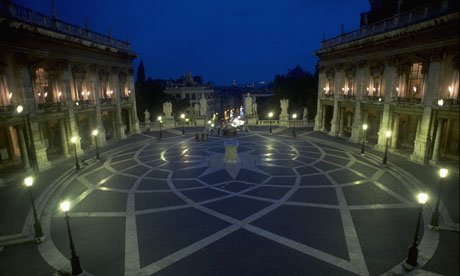 Piazza del Campidoglio, Rome Photograph: Richard T Nowitz/Corbis
Piazza del Campidoglio, Rome Photograph: Richard T Nowitz/Corbis
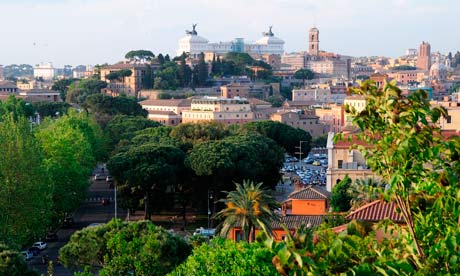
The Orange Garden (Giardino degli Aranci) on the Aventine is, as you would expect, strong on orange trees but distinctly short on grass. However, compensation comes in the form of wonderful panoramas it gives over much of the city, particularly towards St Peter's, and extreme tranquillity (usually – children do play here after school). In fact the Aventine hill, now a superior residential quarter near the centre of the city, is almost all rather leafy and tranquil. Dotted around are also a number of very ancient churches, of which the most beautiful, the sublime S Sabina, large and mostly 5th-century, is right next to the Orange Garden and well worth visiting. Down the road, in the Piazza dei Cavalieri di Malta, is the famous keyhole view of St Peter's.
• Via di S Sabina, corner of Piazza Pietro d'Illiria, and is open every day from sunrise to sunset. Free
The Celio hill – up above the Colosseum and a good place to escape to if you are flagging from the rigours of visiting the archaeological heart of the city – boasts numerous Roman remains, several very early churches and two interlinked parks. The gardens of Villa Celimontana have many fine trees and are focused on a handsome 17th-century villa, while the Parco del Celio is grassier and shadier. In the immediate vicinity is the church of S Maria in Domnica (Piazza della Navicella) with exquisite 9th-century mosaics and the round church of S Stefano Rotondo (Via di Santo Stefano Rotondo 7), mostly 5th-century and set back in a leafy enclave of extraordinary peace.
• Entrances in Piazza della Navicella and in the Clivo di Scauro. The two parks are open from sunrise to sunset. Free
• Entrances in Piazza della Navicella and in the Clivo di Scauro. The two parks are open from sunrise to sunset. Free
Piazza del Campidoglio at night
 Piazza del Campidoglio, Rome Photograph: Richard T Nowitz/Corbis
Piazza del Campidoglio, Rome Photograph: Richard T Nowitz/Corbis The time to visit this square is after dinner. Crowded during the day, it empties as the evening wears on and by 10pm will be quiet. The exquisitely proportioned space, where you see the masterly hand of Michelangelo as designer and architect, has the Capitolini Museums on each side and at the end, the Palazzo Senatorio, the finest town hall anywhere in the world. Go down the little street to the right of this, to the flat space at the back from which you get a most romantic panorama over the heart of the ancient city. Subtle lighting gives a magical beauty to the assorted ruins below, the Colosseum looming in the background.
• Piazza del Campidoglio is at the top of the Capitoline Hill (Campidoglio)
• Piazza del Campidoglio is at the top of the Capitoline Hill (Campidoglio)
The Orange Garden on the Aventine Hill

The Orange Garden (Giardino degli Aranci) on the Aventine is, as you would expect, strong on orange trees but distinctly short on grass. However, compensation comes in the form of wonderful panoramas it gives over much of the city, particularly towards St Peter's, and extreme tranquillity (usually – children do play here after school). In fact the Aventine hill, now a superior residential quarter near the centre of the city, is almost all rather leafy and tranquil. Dotted around are also a number of very ancient churches, of which the most beautiful, the sublime S Sabina, large and mostly 5th-century, is right next to the Orange Garden and well worth visiting. Down the road, in the Piazza dei Cavalieri di Malta, is the famous keyhole view of St Peter's.
• Via di S Sabina, corner of Piazza Pietro d'Illiria, and is open every day from sunrise to sunset. Free
• John Fort is editor of recent versions of Georgina Masson's classic guide to Rome, The Companion Guide to Rome. He works as a guide in the city, johnfort
Wonderful stuff. More, please!
ReplyDeleteThis is a topic that's close to my heart... Many thanks! Where are your contact details though?
ReplyDeleteHere is my web site; ideal waist to hip ratio
Also see my page > ideal waist to hip ratio